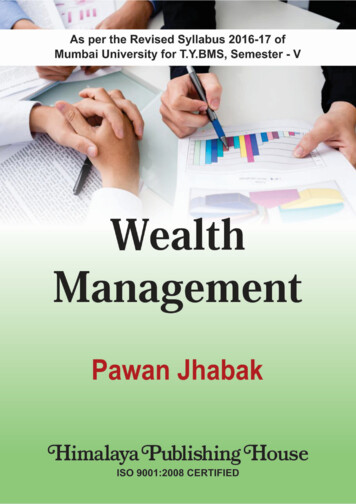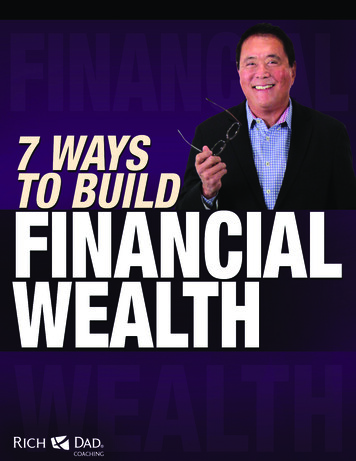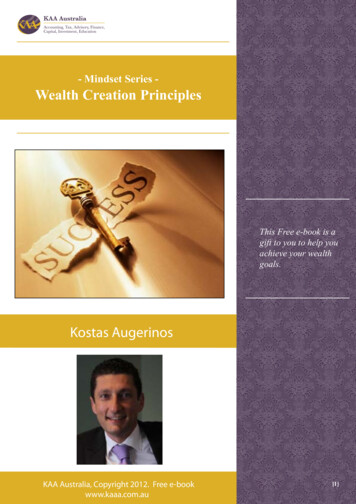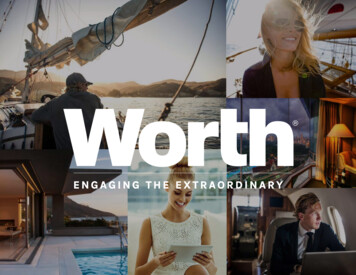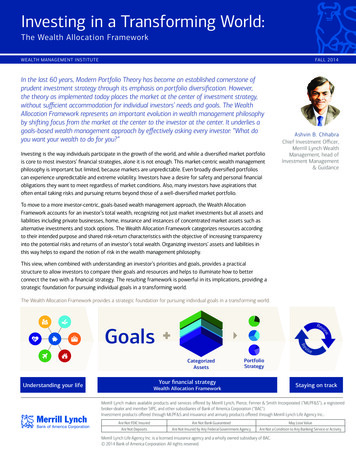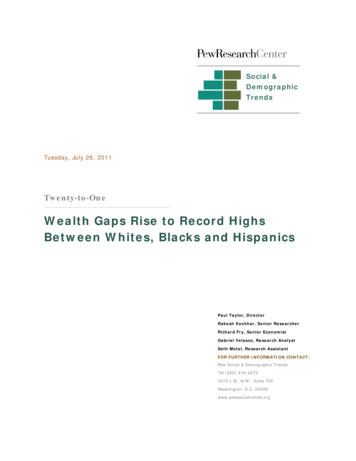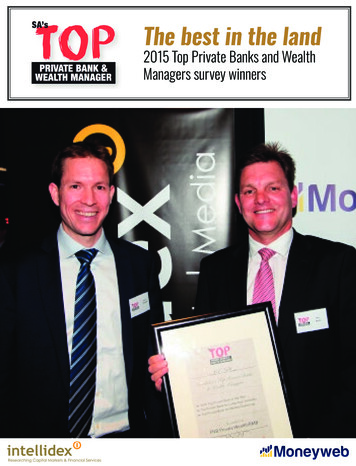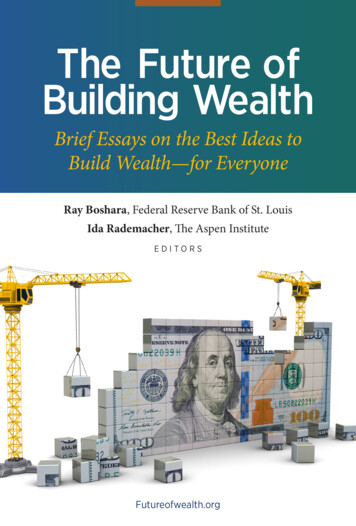
Transcription
The Future ofBuilding WealthBrief Essays on the Best Ideas toBuild Wealth—for EveryoneRay Boshara, Federal Reserve Bank of St. LouisIda Rademacher, The Aspen InstituteEDITORSFutureofwealth.org
Federal Reserve Bank of St. Louis1 Federal Reserve Bank PlazaSt. Louis, MO 63102The Aspen Institute2300 N St NW #700Washington, DC 20037Editors:Ray Boshara, Federal Reserve Bank of St. LouisIda Rademacher, The Aspen InstituteCopyright 2021. Federal Reserve Bank of St. Louis and the Aspen Institute. This bookmay be reproduced in whole or in part provided that it is for noncommercial, personalor educational purposes only (i.e., not for private gain), and appropriately credited toits author or authors and the Federal Reserve Bank of St. Louis and the Aspen Institute.The views expressed herein do not necessarily reflect the views of the Federal ReserveBank of St. Louis, the Aspen Institute, the Board of Governors of the Federal ReserveSystem or the Federal Reserve System.Printed in the United States of Americafutureofwealth.orgThe Aspen Institute logos are registered trademarks of the Aspen Institute and are used with permission.The use of such marks does not constitute or imply an endorsement or recommendation of the views,opinions, products, or services of any person or entity by the Aspen Institute.Federal Reserve Bank logos are registered trademarks of the Federal Reserve Bank of St. Louis and are used withpermission. The use of such marks does not constitute or imply an endorsement or recommendation of the views,opinions, products, or services of any person or entity.Cover image via Getty Images
The Future of BuildingWealth: Brief Essays onthe Best Ideas to BuildWealth—for EveryonePU BLISHED BY T H E F E D E R A L R E SE RVE BA N K O F ST. LO U I S& T H E ASP E N IN ST IT UTE
ACKNOWLEDGMENTS. . . . . . . . . . . . . . . . . . . . . . . . . . . . . . . . . . . . . . 9FOREWORD. . . . . . . . . . . . . . . . . . . . . . . . . . . . . . . . . . . . . . . . . . . .11Capstones and CornerstonesBy James BullardINTRODU C T ION. . . . . . . . . . . . . . . . . . . . . . . . . . . . . . . . . . . . . . . . . 1 3By Ray Boshara and Ida RademacherSECTION I. . . . . . . . . . . . . . . . . . . . . . . . . . . . . . . . . . . . . . . . . . . . . 1 9The New Baseline: The State of Family Wealth andWealth Inequality TodayUnequal Starting Points: A Demographic Lens Is Keyfor Inclusive Wealth Building . . . . . . . . . . . . . . . . . . . . . . . . . . . . . . . . . . . . . . 23By Ana Hernández Kent and Lowell R. RickettsCash Remains King . . . . . . . . . . . . . . . . . . . . . . . . . . . . . . . . . . . . . . . . . . . . . . . 31By Kathryn Edwards and Bradley HardyThe Generational Wealth Gap: Facing the Future butFalling Further Behind . . . . . . . . . . . . . . . . . . . . . . . . . . . . . . . . . . . . . . . . . . . . 37By Fenaba R. Addo and Reid CramerAfter Half a Century, the Racial Wealth Gap Remains Wide— Suggesting Bold Responses Are Warranted . . . . . . . . . . . . . . . . . . . . . . . 45By Kilolo Kijakazi and Signe-Mary McKernanUnderstanding the Gender Wealth Gap, and Why It Matters . . . . . . . . . . . 53By Mariko Chang, Ana Hernández Kent and Heather McCullochHow Should We Finance Postsecondary Education: Debt,Private Wealth or Public Wealth? . . . . . . . . . . . . . . . . . . . . . . . . . . . . . . . . . . 61By Fabian T. Pfeffer and Lowell R. Ricketts2 Harvesting Opportunity: The Power of Regional Food System Investments to Transform Communities
SECTION II . . . . . . . . . . . . . . . . . . . . . . . . . . . . . . . . . . . . . . . . . . . . 67Inclusion and Equity by DesignWithout Financial Inclusion, We’ll Never Achieve Racial Equity . . . . . . . . 71By Angela Glover BlackwellWhy Stakeholder and Community Voice Matter . . . . . . . . . . . . . . . . . . . . . . 77By Aisha Nyandoro, Ph.D.We Have Clean Water and Clean Air: Why Not Clean Finance, Too?A Vision for Inclusion and Equity . . . . . . . . . . . . . . . . . . . . . . . . . . . . . . . . . . . 83By Jin Huang, Michael Sherraden and Margaret S. SherradenToward a More Inclusive and Equitable Financial System . . . . . . . . . . . . . . 91By Salah Goss and Jennifer TescherIncluding Black Investors: Let’s Start with Youth . . . . . . . . . . . . . . . . . . . . . 97By Stephanie J. Creary and John W. Rogers, Jr.Overcoming Systemic Financial Exclusion of People with Disabilitiesin CRA and CRA Modernization . . . . . . . . . . . . . . . . . . . . . . . . . . . . . . . . . . . 105By Michael Morris and Nanette GoodmanRethink Public Policies to Support Income Production, Savings andAsset Accumulation for People with Disabilities . . . . . . . . . . . . . . . . . . . . 113By Michael Morris and Nanette GoodmanPartners for Rural Transformation—Driving Ownership and EconomicOpportunity In Persistently Poor Places . . . . . . . . . . . . . . . . . . . . . . . . . . . 119By José QuiñonezWealth Building for Native Families and Communities . . . . . . . . . . . . . . . 127By Christy Finsel (Osage) and Karen Edwards (Choctaw)Building Financial Security for Essential—But Invisible—ImmigrantWorkers . . . . . . . . . . . . . . . . . . . . . . . . . . . . . . . . . . . . . . . . . . . . . . . . . . . . . . . 135By José A. QuiñonezAdvancing Racial Equity Through Inclusive Community Growth . . . . . . . 141By Ellis Carr3
SECTION III . . . . . . . . . . . . . . . . . . . . . . . . . . . . . . . . . . . . . . . . . . 1 49Stronger Balance Sheets: Financial Services,Cash and SavingsReimagining Financial Services Not Around the Livesof Others: A Call For Radical Action . . . . . . . . . . . . . . . . . . . . . . . . . . . . . . . 153By Bob AnnibaleMeeting People Where They Are and Laying a Foundationfor the Future: Solving America’s Emergency Savings Crisis . . . . . . . . . . 161By Deborah Winshel and Timothy FlackeJust Give People Money. But How and When? . . . . . . . . . . . . . . . . . . . . . . 169By Jonathan Morduch and Rachel SchneiderFrontiers in Financial Capability: Bringing Technology and CoachingTogether to Strengthen Family Balance Sheets . . . . . . . . . . . . . . . . . . . . . 175By Mae Watson Grote and J. Michael CollinsA Golden Moment: Using Tax Refunds to Build Savings and PromoteEconomic Mobility . . . . . . . . . . . . . . . . . . . . . . . . . . . . . . . . . . . . . . . . . . . . . . 183By Stephen Roll and Michal Grinstein-WeissHuman Service Professionals: A Ready Workforcefor Financial Capability . . . . . . . . . . . . . . . . . . . . . . . . . . . . . . . . . . . . . . . . . . 193By Margaret S. Sherraden, Jin Huang and Jenny L. JonesThe Financial Urgency of Now—and the Promise of Fintech . . . . . . . . . . 201By Wole CoaxumSECTION IV. . . . . . . . . . . . . . . . . . . . . . . . . . . . . . . . . . . . . . . . . . . 2 09Stronger Family Balance Sheets: DebtsBringing Dignity to Debts . . . . . . . . . . . . . . . . . . . . . . . . . . . . . . . . . . . . . . . 213By Frederick F. WherryRespond, Restructure, Rebound: A Path to Prosperity Following aFinancial Shock . . . . . . . . . . . . . . . . . . . . . . . . . . . . . . . . . . . . . . . . . . . . . . . . . 219By R. Jerry NemorinFair Fines and Fees: How San Francisco is Leading the NationalMovement for Financial Justice . . . . . . . . . . . . . . . . . . . . . . . . . . . . . . . . . . . 225By José Cisneros and Anne Stuhldreher4
Generational Double Threat—and Opportunity:Student Loans and Retirement Security . . . . . . . . . . . . . . . . . . . . . . . . . . . 231By Diego Martinez and Romy F. ParzickDebt Collectors Are Coming to Court—But We Can ProtectFamilies from Losing Wealth They Shouldn’t Have to Lose . . . . . . . . . . . 239By Erika RickardSECTION V . . . . . . . . . . . . . . . . . . . . . . . . . . . . . . . . . . . . . . . . . . . 247Stronger Family Balance Sheets: AssetsTransforming 529 College Savings Plans: Grow Assetsfor Everyone, Grow the Country . . . . . . . . . . . . . . . . . . . . . . . . . . . . . . . . . . 251By Michael Sherraden and Margaret M. ClancyMeeting the Task of Closing the Racial Wealth Gap:Reparations for Black American Descendants of U.S. Slavery . . . . . . . . . 259By William A. Darity Jr. and A. Kirsten MullenThree Bold Proposals to Overcome Our Nation’sEnduring Racial Wealth Gap . . . . . . . . . . . . . . . . . . . . . . . . . . . . . . . . . . . . . . 265By Darrick Hamilton and Naomi ZewdeA Risk-Free Way to Build Wealth? Forget It . . . . . . . . . . . . . . . . . . . . . . . . 273By Allison SchragerOur Older Versus Our Younger Selves: Time Travel,Wealth and Family Formation . . . . . . . . . . . . . . . . . . . . . . . . . . . . . . . . . . . . 279By Scott WinshipTwo Is Wealthier Than One: Marital Status andWealth Outcomes Among Preretirement Adults . . . . . . . . . . . . . . . . . . . . 285By W. Bradford WilcoxBuilding Wealth by Investing in Four Forms of Capital . . . . . . . . . . . . . . . 293By Ross DeVol and David ShidelerShow Me the Money: To Build Wealth Inclusively,Look to Where People Accumulate and Government Subsidizes It . . . . . 301By C. Eugene Steuerle and Safia SayedLand and Opportunity: Reforming Heirs Property Rights . . . . . . . . . . . 309By Karama Neal, PhDBlack Homeownership Matters . . . . . . . . . . . . . . . . . . . . . . . . . . . . . . . . . . . 317By Vanessa Perry and Janneke Ratcliffe5
Building Wealth Inclusively Through Business Ownership . . . . . . . . . . . . 325By Joyce KleinHow College Degrees Can Become Assets, Not Liabilities,for Disadvantaged Students . . . . . . . . . . . . . . . . . . . . . . . . . . . . . . . . . . . . . . 333By Kevin CareyBuilding Human Capital and Assets for ThoseWithout a College Degree . . . . . . . . . . . . . . . . . . . . . . . . . . . . . . . . . . . . . . . 339By Oren CassHow Child Savings Accounts Can Offer All Childrenthe Future They Deserve . . . . . . . . . . . . . . . . . . . . . . . . . . . . . . . . . . . . . . . . . 345By William Elliott IIIAchieving a Holistic, Inclusive, People-CentricRetirement Savings System . . . . . . . . . . . . . . . . . . . . . . . . . . . . . . . . . . . . . . 351By Karen Biddle Andres and David C. JohnSECTION VI. . . . . . . . . . . . . . . . . . . . . . . . . . . . . . . . . . . . . . . . . . . 357Sharing Risks and Rewards, and Protecting Family WealthThe Mission Economy and Our “Earthshot”:Socializing Risks and Rewards . . . . . . . . . . . . . . . . . . . . . . . . . . . . . . . . . . . 361By Mariana MazzucatoBroadening Ownership First Requires Rewriting the Rules ofDebtors and Creditors . . . . . . . . . . . . . . . . . . . . . . . . . . . . . . . . . . . . . . . . . . . 369By Katharina PistorFrom Safety Net to Building Wealth: Make It Cash, Make It PeopleCentered and Make It Automatic . . . . . . . . . . . . . . . . . . . . . . . . . . . . . . . . . . 375By Rachel BlackOur Nation Insures Losing Your Income—Why Not Also Losing YourWealth? . . . . . . . . . . . . . . . . . . . . . . . . . . . . . . . . . . . . . . . . . . . . . . . . . . . . . . . 381By Ray Boshara and Ida RademacherAmerican Families Need an Operation Warp Speed for SustainableFinancial Tools: Lessons from Vaccine Development and Trials . . . . . . . . 389By Mark Greene6
SECTION VII . . . . . . . . . . . . . . . . . . . . . . . . . . . . . . . . . . . . . . . . . . 397Newer Forms of Ownership: Moving Beyond Earned Income andBeyond SilosFrom Social Insurance to Social Inheritance:A Path to Universal Financial Security . . . . . . . . . . . . . . . . . . . . . . . . . . . . . 401By Peter BarnesFrom My Data to Our Data: A Proposal to EquitablyDistribute Wealth in a Digital Economy . . . . . . . . . . . . . . . . . . . . . . . . . . . 407By Yakov Feygin, Nicolas Vincent, Hanlin Li, Chirag Lala and Luisa ScarcellaThe Community Investment Trust: RevolutionizingOwnership in Real Estate, One Investor at a Time . . . . . . . . . . . . . . . . . . . 415By John W. HainesA New Boogeyman? How Corporate Consolidation Undermines SmallBusinesses, Family Wealth and the American Dream . . . . . . . . . . . . . . . . 421By Phillip Longman and Barry C. LynnDeriving Income from Universal Capital Accounts:Fixing Our Broken Income Distribution System . . . . . . . . . . . . . . . . . . . . 429By Roland M. AttenboroughWhy Profit Sharing is Essential for Building Middle-ClassIncomes and Wealth . . . . . . . . . . . . . . . . . . . . . . . . . . . . . . . . . . . . . . . . . . . . 435By Joseph R. Blasi and Douglas L. KruseThe Untapped Potential of Employee Ownership toNarrow Gender and Racial Wealth Gaps . . . . . . . . . . . . . . . . . . . . . . . . . . . 441By Janet BoguslawFamily Wealth Building Isn’t Enough: We Must PursueCommunity Wealth Building As Well . . . . . . . . . . . . . . . . . . . . . . . . . . . . . 447By Ted Howard and Sarah McKinleyTransforming Systems to Build Racial and Ethnic Wealth Equity . . . . . . 455By Ianna Kachoris and Dr. Helene GayleLending Where Others Will Not: How CDFIs Build Familyand Community Wealth . . . . . . . . . . . . . . . . . . . . . . . . . . . . . . . . . . . . . . . . . . 461By Brent Howell, Lisa Mensah and Dafina WilliamsBuilding Agency and Ownership in the Deep South . . . . . . . . . . . . . . . . . 469By William J. (Bill) Bynum and Ed Sivak7
SECTION VIII. . . . . . . . . . . . . . . . . . . . . . . . . . . . . . . . . . . . . . . . . . 47 7Growing Wealth, Growing the EconomyFamily Wealth as an Engine for Macroeconomic Growth . . . . . . . . . . . . . 481By Karen Dynan and Abigail WozniakReducing Racial Wealth Gaps—And Why That Mattersfor Families and the Economy . . . . . . . . . . . . . . . . . . . . . . . . . . . . . . . . . . . 489by Brenden McKinney, Nick Noel, Duwain Pinder and Shelley StewartA Citizen’s Wealth Fund: Broadening Asset Ownership, ReducingInequality and Stabilizing the System . . . . . . . . . . . . . . . . . . . . . . . . . . . . . 497By Mark Blyth and Eric LonerganSECTION IX. . . . . . . . . . . . . . . . . . . . . . . . . . . . . . . . . . . . . . . . . . . 5 05Moderated Conversation Among Federal Reserve Bank PresidentsThoughts on Wealth Inequality, Financial Inclusionand the Racial and Other Wealth Gaps . . . . . . . . . . . . . . . . . . . . . . . . . . . . 507A Conversation Between James Bullard, President, Federal Reserve Bank ofSt. Louis; Raphael Bostic President, Federal Reserve Bank of Atlanta; Patrick T.Harker, President, Federal Reserve Bank of Philadelphia; and Neel Kashkari,President, Federal Reserve Bank of Minneapolis8
AC K N OW L E D GME N TSWithout the ideas, inspiration and contributions of so many people, thisbook would not have been possible. Any book is a true team effort, and thisone is no different.As mentioned in our introduction, several of the ideas in this book wereincubated in dialogues and retreats organized by the Aspen Institute overthe last few years. However, what really ignited the book was what we informally called our “Wednesday Wealth Working Group”—a series of agendaless Zoom meetings over the summer and fall of 2020 aimed at making senseof the confluence of the pandemic, recession, and national moment of racialreckoning—all of them arising in an era of already alarming levels of economicinequality. What, we wondered, did all these events mean for the inclusivewealth-building agenda that most of us have dedicated our professional livesto? What were—are—the threats, challenges and, especially, the opportunities? Could this be a generation-defining opportunity for our field? Could thecountry afford for it not to be? What would be the consequences of missingthis moment to compel real change? Without the encouragement, insights andgenerous contributions of Dorothy Brown, Tim Flacke, Darrick Hamilton, EdSivak and Jennifer Tescher, this book simply would not have existed; they alsohelped make the book much better. We cannot thank you enough.We also each have our invaluable teams to thank. Ida is grateful to theAspen Financial Security Program team, especially Karen Andres, DyvonneBody, Katherine McKay, Genevieve Melford, Joanna Smith-Ramani, EmyUrban and Elizabeth Vivirito. They lent their substantive areas of expertiseas well as their excellent editing, framing, media and organizational skills tothe book, which is immensely better because of their contributions. We alsoare grateful to the Citi Foundation for supporting the creation of an online“home” for the book (futureofwealth.org), which will build out over time withadditional commentary, events and other content that amplify and expandthe ideas in the book—and support broader engagement and impact amongpublic, private, philanthropic, nonprofit and academic sector stakeholders.9
Ray would like to acknowledge the superb contributions of Ana HernándezKent and Lowell R. Ricketts, who not only co-authored a few essays but alsogenerously provided research assistance to several other authors. Along withWilliam R. Emmons, Lowell, Ana and Ray constituted the core team of theSt. Louis Fed’s Center for Household Financial Stability before it evolved, earlier this year, into the Institute for Economic Equity, now led by its inauguraldirector, William M. Rodgers III. The Center’s focus on household balancesheets, especially its Demographics of Wealth series, was foundational for thebook’s conception and evolution.The excellent contributions of the St. Louis Fed’s contracts, legal, financial management, editing, design, production, media and communicationsteams deserve special recognition too, in particular: Katie Bohl, MatuschkaLindo Briggs, Loree Carvelot, Ally Davis, Brian Ebert, Sarah Hamilton, MariaHasenstab, John Hayes, Rachel Hill, Antonn Park, Daniel Riordan, MonicaShields, Rachel Siegel and Joni Williams. It was of course no small task tomanage all the contracts, communications, graphs, edits, layouts and idiosyncrasies of over 100 authors! Ray also deeply appreciates the enthusiastic support of several members of St. Louis Fed’s leadership team, especially KarenBranding, James Bullard, Daniel Paul Davis and Kathleen O. Paese. Whenthe pandemic created a demand for projects none of us had planned for, theyeagerly lent their support for this book.Finally, without the extraordinary authors who accepted our invitation tocontribute, this book would of course not exist. As they managed their ownpersonal and professional challenges arising from the very conditions—pandemic, recession, racial reckoning—that birthed this book, they graciouslyand enthusiastically found time to pen original essays for this volume. Thankyou, all 106 of you, for making this book possible. We hope you’re as proud aswe are of what we produced together.Ray Boshara & Ida RademacherJuly 202110
FOR E WOR DCapstones andCornerstonesBY JA ME S B U L LA R DPresident and CEO, Federal Reserve Bank of St. LouisThought leadership has always been central to the mission of the St. LouisFed, particularly in monetary policy, economic research and education,and community development. In that spirit, I’m proud that our Institute forEconomic Equity, launched earlier this year, has published The Future ofBuilding Wealth: Brief Essays on the Best Ideas to Build Wealth—for Everyone,a book led by Ray Boshara, an Institute senior advisor.The book builds on the success of our recently sunset Center for HouseholdFinancial Stability, formed by Ray and St. Louis Fed economist William R.Emmons in 2013 in the wake of the Great Recession to study family balancesheets. In fact, in many ways the book serves as a capstone of the Center’sefforts to document and address stark racial, educational, generational andgender wealth gaps in the U.S. But the book also serves as a cornerstone of theCenter’s successor, the Institute, which was launched on the belief that wealthequity remains essential to overall economic equity.In presenting the book’s 63 essays, we have two main goals. The first is tooffer some of the latest and best thinking about ways to help struggling families build or rebuild their balance sheets—especially those families who haveyet to recover the wealth they lost in the Great Recession or, more recently,during the COVID-19 pandemic. Our second goal is to expand our horizonsby exploring novel ways for low-wealth families to generate savings, assetsand financial security. The book asks, and begins to answer, the critical and11
frontier questions: What does property ownership mean in the 21st century, and how can our nation broaden it for those who own little? Are thereuntapped national assets that could generate value for households if we recognize and monetize them as such? Can new forms of national wealth alsogenerate new wealth for those families lacking it?These questions could not be timelier and more essential in the wake of theCOVID-19 pandemic, a recession, a national conversation on racial equity,and persistently high and increasing levels of income and wealth inequality.I’m also excited to note that the book concludes with a conversation I hadwith three other Federal Reserve Bank presidents—Raphael Bostic of Atlanta,Patrick T. Harker of Philadelphia and Neel Kashkari of Minneapolis. As theconversation reveals, addressing wealth inequality and moving toward racial,educational, generational and gender equity are key goals for my Fed colleagues and me. Narrowing these gaps holds the potential to grow our economy as well, as some of the essays in the volume also observe.Finally, let me say that the St. Louis Fed is pleased to have published thisbook with the Financial Security Program of the Aspen Institute, a widelyrespected, nonpartisan think tank committed to leadership, debate and promising ideas. I hope that you find this book as stimulating as I have, and I lookforward to the important and spirited conversations it is certain to prompt.12
IntroductionBY RAY B OSH A RA A N D I DA RA D E M AC H ERThe seeds for this book were planted several years ago through a series ofdialogues at the Aspen Institute on the future of building wealth and ownership inclusively in America. The real impetus compelling its birth, however,came during an extraordinary convergence of events in 2020: a public healthcrisis, the disparate economic impacts that the crisis amplified and a nationalmoment of racial reckoning. It felt—feels—like a rare moment of opportunity.A Historic MomentAs documented by some of the authors in this volume, COVID-19 exposedand is likely to exacerbate the already stark economic inequalities our nationreached by the end of 2019. Prior to COVID-19 there was resounding evidence that, in the midst of the longest economic expansion in modern history, the U.S. was marking levels of income and wealth inequality not seenin a century. Coming into the pandemic, most households had not recoveredeconomically from the Great Recession, especially observable in the declining wealth and increasing debts of less educated, younger, female-headed andnon-white families. When the economic shock of COVID-19 was inflictedon their fragile balance sheets, we witnessed the extent to which financial13
precarity had become the defining characteristic of millions of families and simultaneously watched the net worth of others grow at their most robustrates in decades.The persistence and depth of income and wealth inequality have, in turn,prompted serious national reflection on the fairness and sustainability ofour current policies and systems. What level of economic inequality are weas a nation willing to allow? At what pointdoes pervasive household financial insecurityHigh levels of inequalityhave, historically, preceded weaken the prospects of a robust economicrecovery? High levels of inequality have, hisand prompted an updatetorically, preceded and prompted an update ofof our social contract; haveour social contract, as the major reforms of thewe reached another one of Progressive Era, New Deal, and Great Societythose inflection points inpowerfully suggest. Have we reached anotherour history?one of those inflection points in our history?It may be too soon to label this era of historic social and economic reform—but it’s not too early to offer some ideasthat could underlie those reforms. It is in that spirit that we reached out toover 100 innovative and influential thinkers to invite them to contribute anessay to this volume. The request was straightforward: What are your best andmost promising ideas to address our nation’s profound racial, generational,educational and gender wealth gaps?Why Wealth?Why are we focusing on wealth gaps, specifically? While income inequalityremains deeply troubling—and is both a driver and consequence of wealthinequality—we believe that wealth or net worth (all your savings and assets,minus all your debts) is both a unique and powerful barometer of economicresilience and opportunity and a key component of broader economic equity.Building on a deeply ingrained tradition of broadening property ownershipin the U.S.—articulated by, among others, Thomas Paine in the 18th century,George Henry in the 19th and Louis Kelso in the 20th—we focus on wealthfor three reasons.First, as Michael Sherraden in argued in 1991, assets—as distinct fromincome—serve as both a cushion against challenging financial times and a14
springboard toward better times: the ability to make investments in a firsthome, small business, postsecondary education or skills, a reliable car, retirement security, and future generations. Second, assets change heads: Manyscholars in this volume and beyond have documented powerful “asset effects,”such as youth developing a “college-bound identity” from modest amountsof college savings in their name, or mothers who have better mental healthand higher expectations for their children because of the assets in an at-birthChild Development Account.And third, public policy has played an outsized role in determining who isincentivized to build wealth—and who is not. Most notably, of course, is ournation’s lamentable history of taking land fromNative peoples and then giving or subsidizing The central theme of thisland and other assets to overwhelmingly white book is inclusion: if publicpeople while legally or effectively barring Black policy has actively orand other people of color from accumulatingeffectively excluded certainwealth—a fact that best explains the majoritypeople from accumulatingof the racial wealth gap today, as the St. LouisFed and other research have shown. Similarly, wealth, then we arehistorical obstacles to women owning property called to build wealthwell into the 20th century help explain the gen- inclusively—everyone, byder wealth gap today.design, from as early asYet, while legal barriers to wealth accumu- birth, is included in systemslation may no longer remain, public policy—and policies to build wealth.notably tax policy and asset limits in publicassistance programs—still subsidizes wealth accumulation for wealthierhouseholds (most of whom are white) while penalizing it for poorer ones(who are disproportionately people of color). An upside-down policy, forsure.The central theme of this book, then, as well as the focus of a few specificessays, is inclusion: If public policy has actively or effectively excluded certainpeople from accumulating wealth, then we are called to build wealth inclusively—everyone, by design, from as early as birth, is included in systems andpolicies to build wealth. And while there may well be compelling reasons toreduce enduring wealth gaps per se, a more critical challenge, we believe, isto grow wealth among lower-wealth groups so that they can achieve greater15
levels of economic resilience and upward economic mobility.From Why to HowSo that’s why we focus on building wealth inclusively; now we’d like to offera few words on how we have aimed to achieve that in this book.The first way is by insisting that the ideas included here represent the latest evidence-based research and ideas in the field—and that hold potential forscaling up. Just as the early 20th-century local and state experiments looselyfalling under “the Wisconsin Idea” became the basis for many Progressive Eraand New Deal reforms (such as wage insurance, labor rights and progressivetaxation), we hope that the ideas presented in this volume could be the basisfor wealth equity policies in the renewed social contract now under discussion.The second way is by breaking down silos. The clunkily named “assetbuilding” field, like most anti-poverty fields, has been too siloed, so we aim tobring folks working on balance sheets and family wealth together with thosefocusing on a range of ownership strategies: community wealth building;ESOPs (employee stock ownership plans); universal capital accounts; socialinsurance; property rights; and entirely new ways of conceiving and broadening wealth through, for example, a sovereign wealth fund, a data dividend,social inheritance, and reforms to corporate consolidation.And our third way is by challenging longheldassumptions. As reflected in many of theWe must improve the waysessays focused on novel ways to build wealth,we value and compensatewe were skeptical of the resigned view that theworkers in this country,best we can do for the majority of families inand we also must inviteAmerica today is help them manage scarcity—fresh thinking on how weand that labor-market income and existingcan create new sources ofsafety nets, both meriting improvements, cancapital
Building Wealth Brief Essays on the Best Ideas to Build Wealth—for Everyone Futureofwealth.org . Debt Collectors Are Coming to Court—But We Can Protect . Transforming 529 College Savings Plans: Grow Assets for Everyone, Grow the Country . 251 By Michael Sherraden and Margaret M. Clancy Meeting the Task of Closing the Racial Wealth .


